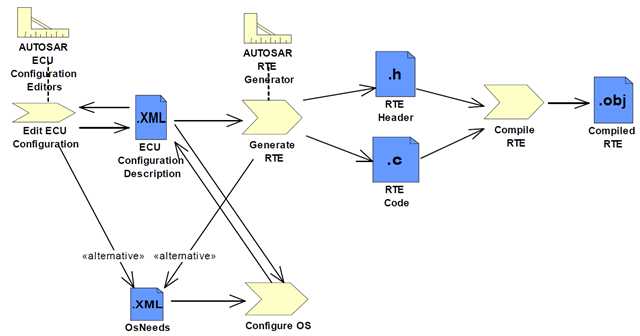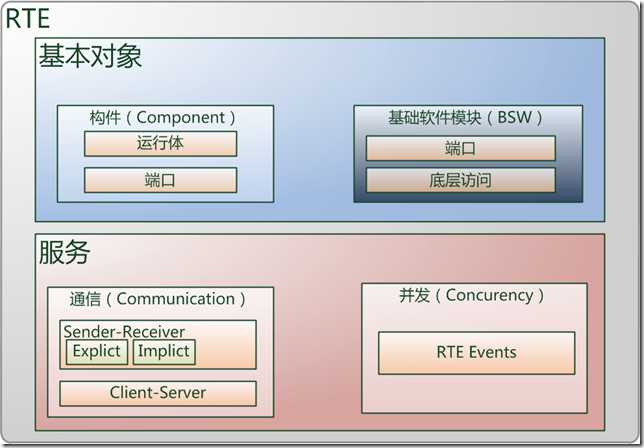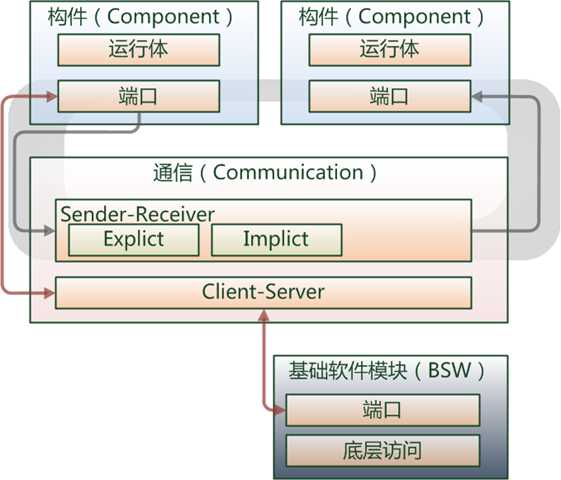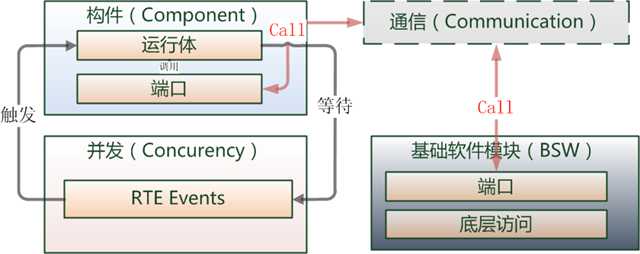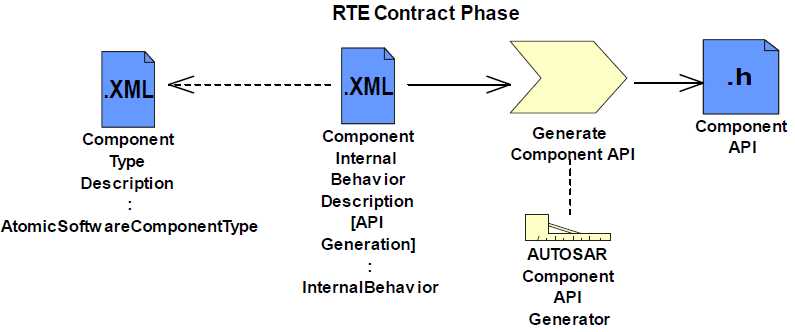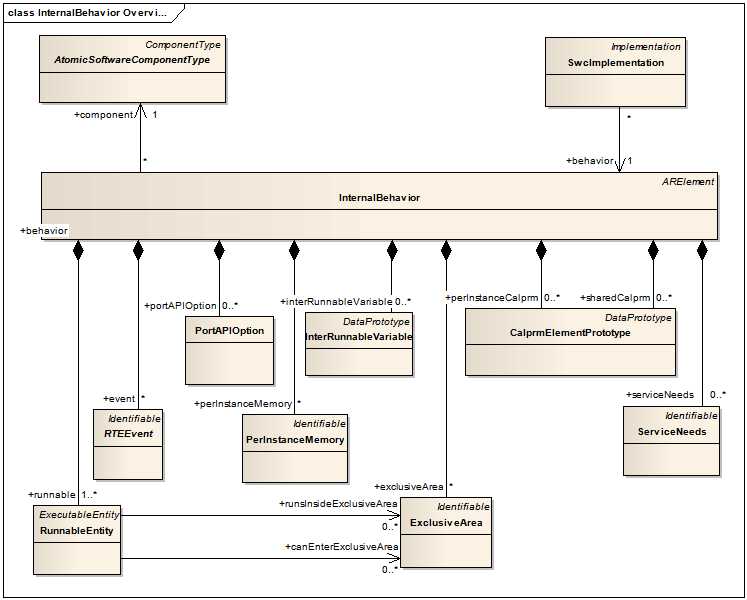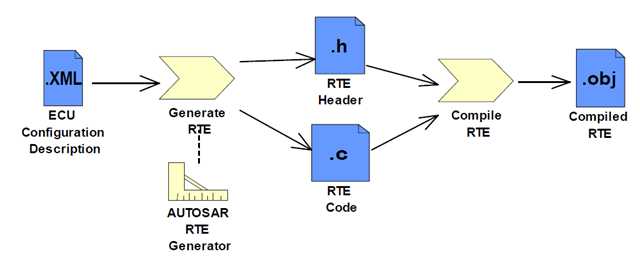1. RTE概述
The Run-Time Environment (RTE) is at the heart of the AUTOSAR ECU architecture.
The RTE is the realization (for a particular ECU) of the interfaces of the AUTOSAR
Virtual Function Bus (VFB).
RTE是AUTOSAR中VFB的接口实现。
The RTE provides the infrastructure services that enable
communication to occur between AUTOSAR software-components as well as acting as
the means by which AUTOSAR software-components access basic software modules
including the OS and communication service.
RTE提供基础的通信服务,支持软件构件间和软件构件到基础软件模块的通信。
The RTE encompasses both the variable elements of the system infrastructure that
arise from the different mappings of components to ECUs as well as standardized RTE
services.
RTE提供了构件到ECU异构信息的配置从而使得RTE服务标准化。
The RTE is generated for each ECU to ensure that the RTE is optimal for the ECU.
RTE是特定的对于每个ECU生成的。
2. 基本概念
RTE基本对象:
它们间的关系:
1. 通信:
2. 并发
AUTOSAR software-components have no direct access to the OS and hence there are
no "tasks" in an AUTOSAR application. Instead, concurrent activity within AUTOSAR
is based around runnable entities within components that are invoked by the RTE.(P31)
AUTOSAR软件构件不能直接访问操作系统,所以在AUTOSAR应用程序中没有 "task" 的概念,取而代之的是被RTE所管理的构件运行体。
The AUTOSAR VFB specification [13] defines a runnable entity as a "sequence of
instructions that can be started by the Run-Time Environment". A component provides
one2 or more runnable entities [RTE00031] and each runnable entity has exactly one
entry point. An entry point defines the symbol within the software-component‘s code
that provides the implementation of a runnable entity.
每个构件都有一个或多个运行体,但每个运行体只有一个入口。
The RTE is responsible for invoking runnable entities – AUTOSAR software-components
are not able to (dynamically) create private threads of control. Hence,
all activity within an AUTOSAR application is initiated by the triggering of runnable entities
by the RTE as a result of RTEEvents.
因为AUTOSAR软件构件没有能力动态创建线程,所以由RTE负责调入运行体。正因为这样,AUTOSAR所有软件活动都是由RTEEvents引起的。
An RTEEvent encompasses all possible situations that can trigger execution of a runnable
entity by the RTE.
RTEEvents 试图把所有可能触发任务的事件都包含进来。[The different classes of RTEEvent are defined in Section 5.7.5.]
The RTE supports runnable entities in any component that has an AUTOSAR interface
- this includes AUTOSAR software-components and basic software modules.
RTE支持所有含有AUTOSAR接口的运行体,不仅有SWC,还包括了BSW。
Runnable entities are divided into multiple categories with each catgory supporting different
facilities.
运行体被分为不同的类别,以便支持不同的设备。[The categories supported by the RTE are described in Section 4.2.2.2.]
3. RTE生成器
RTE生成器(RTE Generator)是我们最终提供给用户使用的工具,它和操作系统、通信等配置工具联合使用,以实现虚拟总线的真实功能。
RTE生成器的主要功能是:创建与操作系统系统功能相适应的AUTOSAR软件构件API,并管理软件构件间的通信。
这些生成的代码在运行时:
(1)为软件构件分配所需的系统资源,如消息号、任务运行环境等
(2)负责具体执行软件构件间通过端口进行的通信
(3)根据软件构件描述中的信息,在适当时刻为软件构件提供事件或调度。
RTE生成包含两个阶段:(1)定义阶段(RTE Contract phase)(2)生成阶段(RTE Generation phase)。
在(1)定义阶段中,将软件构件和RTE交互描述信息定义为头文件,作为软件构件与RTE的契约,双方都使用相同数据结构进行编程。在此阶段,需要完成的工作是:
l 软件构件类型描述
l 构件内部行为描述
l 真实源代码或目标代码及其API(头文件)生成
l 实现语言描述
从上图中可以清晰的看到,其实定义阶段就是扫描一下InternalBehavior这个xml的标签( ),然后生成它的头文件。
),然后生成它的头文件。
Internal Behavior中可以包含的内容如下:
在(2)生成阶段中,将所有软件构件、相关系统和ECU信息联合起来,为每一个ECU生成一个RTE。
由上图可以看出,生成阶段之前要先收集ECU配置信息,然后进行配置,可配置的内容有:
So first the ‘RTE Configuration Editor‘ needs to collect all the information needed to establish
an operational RTE. This gathering includes information on the SW-Component
instances and their communication relationships, the Runnable Entities and the involved
RTE-Events and so on. The main source for all this information is the ‘ECU
Configuration Description‘, which might provide references to further descriptions like
the SW-Component description or the System Configuration description.
SWC的接口和它们的通信关系。
运行体和它们的RTE-Events。
One extremely important point is the mapping of application signals from SW-Component‘s
ports to COM signals. A mapping of the application signals to system signals
has already been defined by the ‘System Configuration Generator‘ .
还有一个极端重要的内容就是把SWC的端口映射成为COM的信号。映射的规则已经被系统配置生成器( )所描述。
)所描述。
The generated RTE interacts with AUTOSAR COM and OS. For the latter, the RTE
both uses OS objects already in existance (e.g. tasks for which the RTE generator
builds bodies) as well as requires new objects (e.g. a schedule table or periodic alarms
for periodic runnable entities).
The coordination of configuration information between
the OS and RTE is therefore key since both the RTE and OS have to agree upon the
set of OS objects.
RTE生成器使用COM和操作系统已有的对象(如:task),同时也创建自己的新对象(如调度表和周期时钟)。但是如果一个对象OS已经提供,RTE就必须使用。
The AUTOSAR OS is configured in the ECU Configuration Description. The RTE
configurator/generator needs to communicate its needs to the OS and therefore it
seems sensible to use the same format order to allow the communication of the set
of OS object required by the generated RTE.
AUTOSAR OS被ECU配置描述文件所配置。
The specification of the OS objects used by the generated RTE, henceforth termed
OsNeeds, can be done either at configuration time only or at a mixture of configuration
and generation time, depending on which approach is supported by the configuration
and generation tools of RTE and OS. Thus according to figure 3.4 the output information
OsNeeds can be alternatively provided by the RTE Configuration Editor or the RTE
Generator.
如果是操作系统特别需要的对象,就标记上OsNeed。如下图所示:
